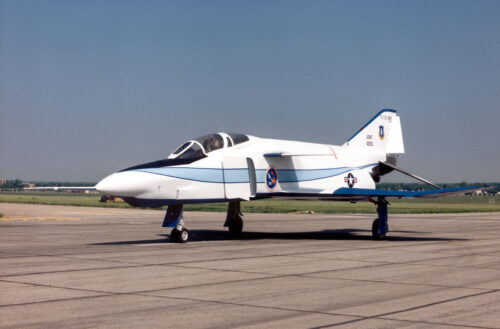Tony Landis of the U.S. Air Force Materiel Command History Office recently detailed the remarkable history of aircraft 62-12200, the McDonnell YF-4E Phantom II. Now housed at the National Museum of the United States Air Force (NMUSAF), this aircraft, though often overlooked, played a pivotal role in advancing fly-by-wire (FBW) technology, setting the stage for the development of modern fighter aircraft.

Originally developed as a Navy F4H-1, the aircraft was adapted for the U.S. Air Force under the designation F-110A Spectre, later reclassified as the F-4C. Serial number 62-12200, initially a YRF-4C reconnaissance aircraft, underwent extensive modifications throughout its service life. Notably, it transitioned from its original role to become the aerodynamic prototype for the F-4E program, receiving the YF-4E designation in 1967.
In 1972, the YF-4E became the testbed for the Survivable Flight Control System (SFCS) program. This system introduced a three-axis analog fly-by-wire control system, marking the first time a fighter aircraft flew with such a configuration. The YF-4E conducted its inaugural SFCS Phase IIA flight on April 29, 1972, at the McDonnell Douglas facility in St. Louis, Missouri. Subsequent testing phases further validated the system’s reliability, culminating in the first FBW aircraft to achieve Mach 2.
The aircraft’s contributions did not end there. Under the Precision Aircraft Control Technology (PACT) program, the YF-4E was modified with canards and fixed wing leading-edge slats, enabling further exploration of Control Configured Vehicle (CCV) concepts. This testing phase, conducted primarily at Edwards AFB, demonstrated the aircraft’s versatility and its role in refining control technologies that would influence future fighter designs.
After the completion of its test programs, the YF-4E was retired from active service in 1974 and placed in storage. The aircraft faced an uncertain future, with the possibility of being scrapped. However, its historical significance caught the attention of James Morris, a project engineer at the Air Force Flight Dynamics Laboratory (AFFDL). Upon learning from colleagues at McDonnell Douglas that the airframe was at risk of being dismantled, Morris took action to preserve the YF-4E.
Morris reached out to the United States Air Force Museum in Dayton, Ohio, advocating for the aircraft’s importance and its role in the evolution of fly-by-wire technology. The museum agreed to accept the aircraft as a donation, but transporting the YF-4E from St. Louis to Dayton presented a logistical challenge.
Morris coordinated with the 272nd Transportation Company at Fort Sill, Oklahoma, to arrange for the aircraft’s transportation. The commanding officer recognized the operation as an excellent training opportunity and dispatched a CH-54B Skycrane heavy-lift helicopter, accompanied by an escort helicopter, to retrieve the YF-4E. On January 9, 1979, the Skycrane successfully lifted the Phantom II from St. Louis and delivered it safely to the NMUSAF.
Today, the YF-4E stands as a testament to the challenges and triumphs in the development of FBW systems, a now-standard feature in contemporary military aircraft. The aircraft’s survival and preservation highlight the efforts of individuals who recognized its historical value and ensured that its legacy would endure for future generations to study and appreciate.
For more information, hit the Source below
Hopefully there will be space in the NMUSAF. This bird will have many tales to share with us.
I built a small free flight version of this plane many years ago. Then set about enlarging for R/C, thats where the problems began. One failure after another servos, fans esc …all failed spelling tg the was another plane down I grew old and dumb thumbed two into the ground. in my basement set two more and a F-4E which might get reworked … why with the number flown during vietnam is there no model of the RF-4 phantoms ? would be so easy to add the canards …lol